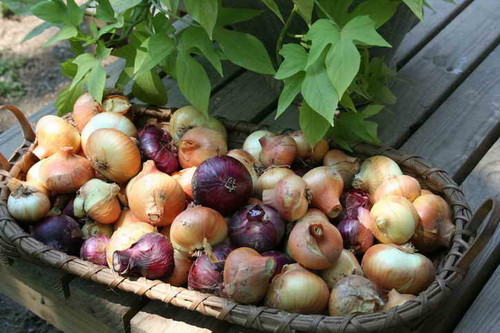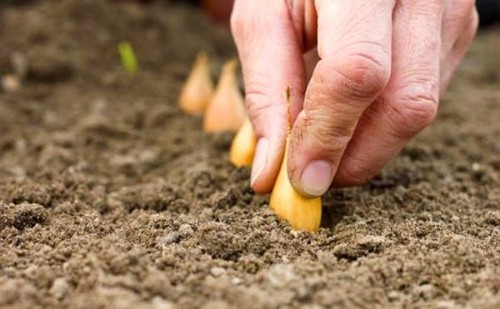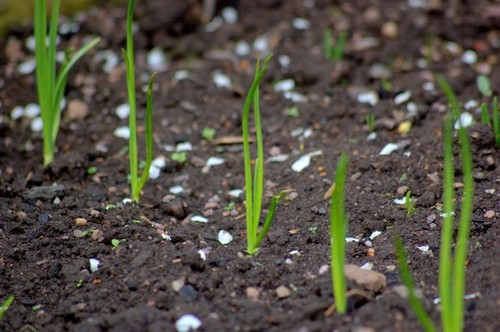Competent and experienced gardeners always “consult” with the stars in order to get a rich harvest. Gardeners have been working according to the Lunar calendar for many years. So in 2017 best month February is the time for sowing this vegetable crop.
What days in February are considered most favorable for working with this vegetable?
- 3.02.
- 4.02.
- 11.02.
- 12.02.
- 15.02.
On other days, you can sow and plant vegetables, but it is highly not recommended to do this from 7.02. to 9.02. There is no need to start onion seedlings before February, as it will still be quite cold outside. But if such a decision has already been made, then the best day in January to plant this crop is 8.02.
As for the remaining months, the following days can be distinguished:
- In March: 3.02, 27.02, 30.02.
- In April: 1.02, 23.02, 27.02.
- In May: 17.02 and 18.02.
Planting containers are usually used for seedlings, but high-quality soil is used for sowing seeds.
How to properly work with onion seedlings?
For planting onions, turf soil mixed with humus or peat is considered ideal. The container in which the seedlings will be placed should be filled with this mixture and compacted slightly.
After 10 days have passed, you can wait for the onion to sprout. On day 10, it is recommended to feed the seedlings a little. You can use liquid fertilizer.
In order for the onions to germinate well, the soil must be regularly moistened during all these days, it is better to do this twice a day.
Seedlings must be in a bright place. The ideal place for it is considered to be a windowsill, since the plant will have access to sunlight, which directly affects its development.
When to plant onion seedlings?
Greenhouses for onion seedlings can be used in gardening, but if this activity is not significant in scale (i.e. a large harvest is not planned). You can grow it on a windowsill at home using a special container.
The best time for seedlings of this vegetable is the beginning or middle of March. So that by the time it is planted it is already 3 months old, it is better to plant onions from March 10 to March 20. The distance between the rows should be about 5 cm, otherwise the plants will not germinate due to crowding. The seeds should be covered with earth approximately 1-1.5 cm. The temperature in the room where the onions were planted should be at least 20 degrees Celsius.
Regarding feeding:
- The first feeding should be no earlier than the tenth day after sowing, i.e. before the first shoots appear.
- The second feeding is done after two weeks.
- The third feeding should take place in a week.
In this case, each time the dose amount should be increased.
When to plant onions in 2017?
After the seedlings have germinated, they can be prepared for planting. In 2017 best time for this it will be May, or rather the middle of it. But before planting directly, the leaves of the onion seedlings should be prepared. To do this, they are cut by 3 cm. This is necessary so that the evaporation surface is slightly reduced during the period of transplanting the seedlings into the ground. You can ignore these rules and trim the onion after it is in the ground. However, as practice shows, if you trim the onion before planting, it will be less susceptible to various diseases.
This vegetable crop is planted in rows of equal length. The distance between plants in a row should be at least 5 cm, and each onion row should be at least 20 cm away from the other. Caring for planted vegetables is not much different from caring for their seeds.
Dates for planting and sowing onions in Siberia and the Urals in 2017
- In Siberia and the Urals, this vegetable crop is usually planted in early May. The best days for this: from May 5 to May 10. Onions are planted in small rows, about 20 cm each. In these parts it is customary to grow it through seeding.
- In the Moscow region and other parts of Russia, onions are planted either in February (as recommended by the lunar calendar) or in the spring. In spring time better days The days for sowing and planting onions are: April 25 and May 5. When the onions are planted in the ground, they are watered and insulated with something, for example, film.
Growing onions from seeds (video)
Rating 0.00 (0 Votes)Attention, TODAY only!
Autumn planting of onions before winter allows you to get not only fresh, vitamin-rich greens in the very early spring, but also strong, juicy bulbs as early as the end of June. Planting before winter has a number of advantages that many summer residents and gardeners enjoy. Despite the risk of freezing in cold, harsh winters, more and more farmers prefer autumn sowing.
SELECTING ONION VARIETIES FOR WINTER SOWING
When planning to plant onions for the winter, you first need to decide for what purpose the planting is being done - to produce greens or turnips. In any case, no matter what seedling you plant, a green feather will grow. When planting onions in the fall, be sure to pay attention to the winter hardiness of the variety; it is recommended to plant sets that are resistant to frost.
It is advisable to buy zoned onion varieties for planting in the fall, suitable for cultivation in a specific area. Before winter, the following varieties of onions are planted: Black Prince, Strigunovsky, Siberian annual, Ellan, Bessonovsky, Stuttgarten Risen, Danilovsky, Chalcedony, Arzamas, etc.
There is one little trick to planting onion sets before winter: the smaller the oat set (oat set), the larger the onion will grow. A small seedling practically does not bolt; a large seedling planted in the fall will shoot almost all of it. It is not recommended to take large set for sowing turnips in the fall. If you decide to start winter crops for the first time, plant several different varieties to understand which onion grows best in the beds in your climate zone.
When to plant onions before winter in 2017
The time to plant onions in winter is determined by the outside temperature. A favorable period is considered to be when the temperature is in the range from 0 °C to +5 °C, provided that the night temperature is not lower than -3 °C, the ground temperature in this case will be +3 °C or +4 °C, which is what is needed for planting seedlings.
Each individual region has its own climatic characteristics, so it is quite difficult to determine the exact time frame for planting seedlings. Gardeners need to independently monitor weather conditions to determine optimal time for sowing wild oats.
Sowing too early can cause the seedlings to germinate, and with the arrival of frost, the planting material will die. For example, in central Russia and the Moscow region, onions begin to be planted in the second week of October and work continues until the end of the month; in Ukraine (for the northern regions), the planting dates shift to October 20-22 and last until November 5-7.
HOW TO PROPERLY PLANT ONIONS IN AUTUMN?
It is preferable to plant onions in sunny areas where water does not accumulate in the spring. The earth is dug up to a depth of 25-30 centimeters, 0.5 buckets of compost, one glass of wood ash are added, all fertilizers are calculated square meter area.
The bed for the seedlings is loosened, then grooves are cut 3-4 centimeters deep at a distance of 11-12 cm. When planted shallowly, the seedling does not tolerate frosts well without snow; in the spring the bulbs will stick out of the ground. Unlike planting in spring, onion sets for autumn sowing do not soak.
Small wild oats are laid out in furrows every 30-40 mm and covered with loose soil mixture or soil. The top is additionally mulched with peat or leaf litter. To get fresh greens in early spring, sow the sets more densely in the fall, every 2 centimeters. In the month of May or earlier, it will be possible to thin out the plantings by pulling out the green onions and leaving the plants for further ripening for turnips.
CARE OF WINTER PLANTINGS IN SPRING
In the spring, as soon as the snow thaws and melts away, the additional mulch layer is removed and sent to compost. The condition of onions planted in the fall can be judged already in April, when the snow melts. If the winter was too cold and little snow, with incorrect agricultural technology, the crops may not grow well. Therefore, it is possible to plant onions again, but you need to plant larger sets in the spring.
To grow large onions planted before winter, in April the plantings must be fed with liquid mullein (1:10). You can speed up the ripening of bulbs using a greenhouse, which can be built on a bed of arcs and film. Any film will do instead non-woven material, retaining and saving heat. Don’t forget to remove weeds from the beds and water them, then the autumn planting of onions before winter will definitely please you with a rich harvest!
A winter that is too harsh can really be a problem for growing onions. But if the plant is well covered, it will survive the frosts safely. And with heavy rainfall, even at the lowest temperature, the onion will be covered with snow, which will provide a suitable climate for plant growth. And so, let’s look in more detail at how and when to plant onions before winter in 2017, in order to get a harvest that will be the envy of everyone, even in the cold Moscow region.
Favorable time for planting
A long time ago, knowledgeable people invented the lunar calendar. And for good reason. After all, based on the dates indicated in this calendar, you can grow the most fastidious crop with very little effort.
So, for the onion in lunar calendar several days are allocated. In September 2017 it is on the 9th, 13th and 19th, in October - on the 6th, 7th and 16th. But there are also “spare” days in November - 7, 12 and 14.
It is better to plant onions in the ground before the onset of cold weather. Favorable days You can also determine it with a thermometer - if for several days the temperature has reached 5 ºC, then that day has come - it’s time to plant the onions.
It is worth considering that you should not plant onions ahead of time. But we keep in mind that before the onset of severe cold, the plant must have time to take root. Otherwise, the bow will give all its strength to the arrow, which will soon die from frost.

Advice: Avid gardeners advise planting onions in November, since September can be very deceiving in terms of temperature.
Selecting a suitable bow
In order to prepare the bulbs for planting, you need to decide for what purpose it will be grown. If you only need greens, then you should plant fruits 3 cm in size. If you need the fruit itself, then we choose the so-called sets - bulbs ranging in size from 1 cm to 3 cm.
On a note: For winter planting professionals still recommend using sevok. If he can be safely landed in open ground, then next year it will bear excellent onion fruits.
Soil preparation
Properly prepared soil plays important role in planting onions before winter. First of all, the soil for planting should not be heavy. For onion, the best “home” will be humus-sandy soil. This “whim” is due to the fact that onions have a special root system. She needs light soil.
Before planting onions, it is important to dig up the soil with the addition of humus and mineral plants. Before planting the bulbs, you can scatter wood ash on the ground.

Beginning gardeners often ask themselves the question: what crop is best to plant onions in place of? Out of ignorance, it often happens that a properly planted onion simply rots in the ground for no apparent reason. It turns out that in the place where the crop was planted, such plants used to grow, after which the onion does not take root.
Do not plant onions in the ground if the following were previously grown in the garden bed:
Legumes;
potato;
celery;
parsley;
Red clover.
Plants, after harvesting which, onions will feel great:
Different varieties of corn;
beet;
mustard;
tomatoes;
cucumbers;
salad;
cabbage.

If plants “harmful” to onions grew in the garden bed, then in a few years this soil will become the most favorable for planting a crop here. It is not recommended to grow vegetables in the same area more than twice, that is, after two years we plan to plant them in a different place. Having harvested the crop in the second year, it is worth taking a break of about 4 years.
Planting bulbs before winter
Preparing the land and selecting bulbs is only half the battle on the path to successfully growing a good onion crop. One of the main points is correct landing.
Important! The recesses for the bulbs do not need to be made too deep. It is recommended to dig furrows in the soil up to 6 cm in size from each other, approximately 20 cm apart.
Dried small sets are laid out in grooves at a distance of about 7 cm from each other. The top of the bulbs should be thoroughly sprinkled with dry soil and gently tamped down with your hand. Immediately after the seedlings are planted, they should not be watered. Only if the weather does not please you with precipitation, and there is no rain at all for ten days after planting, then the crop should be watered.

After the first frost, all the soil where the onions were planted must be covered with dry leaves, you can take pine branches, and also put tree bark on top so that it holds the leaves from strong winds.
If winter brings a lot of snow, then there is no need to cover the onion planting with film. Since the snow cover will cover your onion and create the necessary microclimate for it. But if there is a shortage of precipitation, then polyethylene will come to the rescue. After covering the ground, place bricks or stones on the corners of the film. This will save your shelter from gusty winds.
